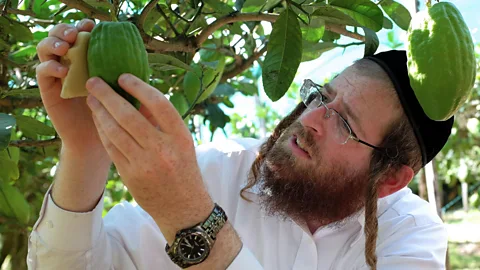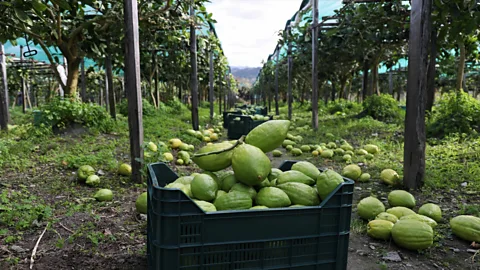Features correspondent
 Eugenio Magurno – Giovanni Carnevale/Consorzio del Cedro di Calabria
Eugenio Magurno – Giovanni Carnevale/Consorzio del Cedro di CalabriaThe most ancient and aromatic of all citrus fruits, citrons are far less known than their renowned yellow and orange cousins. But each summer, they lure Jews from all over the world.
Every summer, in preparation for the Jewish holiday of Sukkot, Hasidic rabbis from all over the world travel to the northern part of Italy’s Calabria region to handpick the best citron fruits for their lulav, the bundle of four plants used to bless the small, temporary huts built every autumn by Jews to celebrate the holiday. For about two weeks, the orchards around the town of Santa Maria del Cedro fill up with English, Russian, Hebrew and Yiddish-speaking rabbis and their families. With the help of local farmers, they inspect the trees and analyse the fruits, sometimes with magnifying glasses, in their quest for citron perfection.
The most ancient and aromatic of all citrus fruits, citrons are far less known than their renowned yellow and orange cousins. They resemble large, green lemons, have more peel than pulp, and with a sour-bitter flavour, they are not considered desirable for home consumption. This means that, outside of Calabria, you won’t typically find them at the supermarket.
But according to the Torah, the etrog (Hebrew for “citron”) is the “fruit of the most beautiful tree”, possibly even the forbidden fruit of the Garden of Eden. And although there are multiple citron varieties around the world, one Jewish community believes that the Calabrian one, known as Liscio Diamante, is the purest and most perfect of all.
 Alberto Pizzoli/AFP/Getty Images
Alberto Pizzoli/AFP/Getty ImagesThe citron plant (Citrus medica) arrived in this region around 2,000 years ago, following Jewish migrations. According to Helena Attlee, author of The Land Where Lemons Grow: The Story of Italy and Its Citrus Fruit, citron was the only citrus species to grow in Europe until oranges arrived 900 years later, brought across North Africa to Spain by the Moors. The Jews were expelled from Calabria (and all of southern Italy) in 1541, but their connection with Calabrian citron farmers lives on to this day and remains crucial to the fruit’s survival.
“It is only thanks to Chabad Jews if this plant still grows here,” Attlee wrote.
Chabad Jews are one of the largest Hasidic Jewish groups in the world, and their link to Calabrian citrons dates to the 1800s, when the group’s founder, Rabbi Schneur Zalman of Liadi, told his followers to prefer Calabrian citrons over all the others. In a story he once told, the founder explained that when God instructed Moses to go look for citrons to commemorate the 40 years in the desert that had just passed, he sent messengers around the world and they came back with Calabrian fruits. Since the 1960s, Rabbi Moshe Lazar, who is based in Milan, personally oversees the process of choosing them.
 Aldo Pavan/Getty Images
Aldo Pavan/Getty Images“Summer has been a special time for as long as I can remember, as that’s when the rabbis come to visit,” said Angelo Adduci, who grew up in a family of citron farmers in Santa Maria del Cedro. “These visits are familiar memories not just for me, but for everyone in town, and Rabbi Lazar is like an uncle to me. It’s a part of our childhood, and a happy one.”
Today, Adduci is president of the Calabrian citron farmers’ union (Consorzio del Cedro di Calabria), which promotes the fruit and connects it to the region’s many natural attractions. The contrast of mountains and sea is one of the area’s most distinctive features.
When I drove to Calabria from northern Italy, I was struck by the fact that in some places, such as the town of San Nicola Arcella, the mountains on my left extended all the way to the sea on my right to form scenic cliffs, sea caves and arches. These imposing mountains, which are part of the Pollino National Park, are a popular destination for hikers and rafters and are home to rare animal and plant species. But squeezed between those mountains and the sea is a strip of farmland where the citron plants grow. This area is called the Riviera dei Cedri (Citron Riviera), and for good reason.
 ChiccoDodiFC/Getty Images
ChiccoDodiFC/Getty Images“[Here] the warm breeze from the sea meets the cold wind from the mountains, and these two winds balance out in the middle, creating the perfect climate for citrons,” Adduci explained.
In general, citrons are mostly used to make candied fruits, confectionery, marmalades, sauces for meat and fish dishes, as well as cedrata, a popular Italian soft drink. In Santa Maria del Cedro, the hub of citron growing, visitors will find specialised citron ice cream shops, bars serving citron cocktails, a citron festival, stores selling citron oil, and even a citron museum, the Museo del Cedro, which recounts the fruit’s history through sensory and olfactory activities. The fruit’s sweet-yet-lemony scent also lends itself to citron perfumes.
When she first visited Calabria, Noemi Disegni, president of the Union of Italian Jewish Communities, found all of this very surprising: “As a Jew, I’ve always associated citron solely with the Sukkot festival, but there’s a whole universe around this mysterious fruit. It has its own cuisine and recipe books, and it comes as the sole ingredient in a range of food products, and even cosmetics. I had absolutely no idea,” she said.
 Eugenio Magurno – Giovanni Carnevale/Consorzio del Cedro di Calabria
Eugenio Magurno – Giovanni Carnevale/Consorzio del Cedro di CalabriaDespite the large-scale production of soft drinks and candied fruits, which end up on supermarket shelves around Italy, citron growing remains extremely niche and is mainly carried out on small family farms or gardens. “That’s because the trees are very vulnerable, and they need lots of care and experience. A wind stronger than average, or a sudden temperature change can destroy the year’s harvest,” Adduci explained. “And even if the climate here is ideal for citron farming, these plants would not stand a chance without the knowledge of the farmers.”
The Citron Experience
Stock up on citron liquor at Liquoreria Italiana in Praia a Mare, while at the Terre del Lao oil mill you’ll find citron-scented olive oil, made by pressing olives and citron peel together.
For a citron-inspired meal in the countryside, check out agriturismo Bonicose in Orso Marso (you can stay the night here, too)
Taking care of citrons is a labour of love. The delicate trees need regular pruning and protection with nets when necessary. Farmers must always make sure the leaves get enough light and air, but also that the fruits are not exposed to direct sun, which might stain their skin, and that the tree doesn’t damage its own fruits with its growing branches, leaves or thorns. Also, Adduci explained, “since the plants are small, farmers have to kneel on the ground in order to take care of them. This also adds a Catholic dimension to it all, because it’s a bit like praying. As we say, it’s a desperate fruit with an incomparable scent.”
If citron growing seems like intensive work, the production of kosher citrons adds an extra layer of complexity. To be certified as kosher, or pure, the etrog needs to come from an ungrafted plant. Cultivating ungrafted plants means giving them lots of extra attention and time as they are more vulnerable to disease, but it also keeps the variety pure throughout generations because there’s no genetic mixing with other plants, which scientists say may happen when plants are grafted.
Once a citron tree is declared kosher, the rabbinical inspection continues on each fruit, following precise rules. The perfect fruit should weigh about 80g, have perfectly smooth skin (no spots or bumps or parasites) and must be neither too round nor too long. The chosen etrogs are then placed in boxes and packed for shipping to Israel, Europe, Russia and the US.
 Eugenio Magurno – Giovanni Carnevale/Consorzio del Cedro di Calabria
Eugenio Magurno – Giovanni Carnevale/Consorzio del Cedro di CalabriaLast October, on the first day of Sukkot, when I opened the white etrog box I’d bought in Berlin from a Chabad rabbi, the citron inside was still perfect. After three months, it hadn’t lost any of its marvellous scent. By autumn, the Calabrian farmers are already preparing for the next season, but, Adduci said, “we feel incredibly proud to know that our fruits have reached the homes of hundreds of families around the world.”
Today the Riviera dei Cedri continues to live up to its name, with many small businesses offering the fruit in creative ways. Visitors to the region can even go on citron tours called La Via del Cedro, which include visits to the orchards, nature walks, tastings and strolls around the ancient Jewish quarters.
“Although there are no Jewish communities left in Calabria today, Italy’s Jewish world is proud of this cultural connection,” said Disegni. These towns’ Jewish past, just like citron, runs deep through the cultural identity of north-western Calabria.
CORRECTION: A previous version of this article incorrectly named Menachem Mendel Schneerson as the founder of the Chabad movement. This has now been updated.
